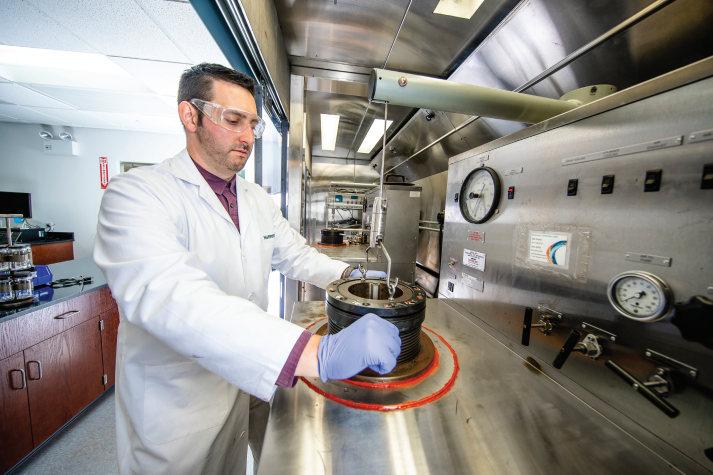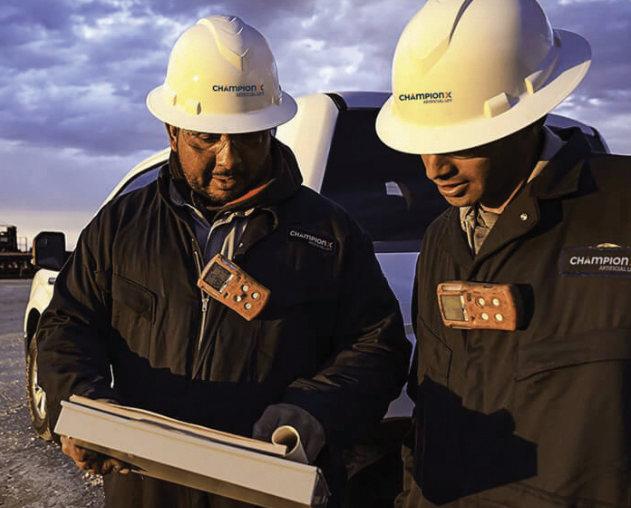
5 minute read
The mitigation of sour corrosion at lower treatment rates
Hussen Ouji, technical lead engineer, ChampionX, discusses how the company performed a chemical qualification study of corrosion inhibitors (CI) for an international oil company in Iraq and customised a treatment programme to alleviate corrosion risk in the field.
Figure 1: ChampionX participated in corrosion testing for a wellhead and central processing facility in Iraq.
CORROSION IS ONE of the most prominent and costly issues facing the oil and gas industry today. With pipelines and associated equipment exposed to extreme environments, from production through to refining, failure to consider or mitigate corrosion can lead to the costly shutdown of operations and potentially create a hazardous and unsafe working environment.
It is estimated that the total annual cost of corrosion in the oil and gas industry is US$1,372bn. This figure can be broken down into US$589mn on surface pipeline and facility costs; US$463mn annually in downhole tubing expenses; and another US$320mn in capital expenditures related to corrosion (https://www.nace.org/resources/industriesnace-serves/oil-gas).
Unlike general corrosion, pitting corrosion is the proliferation of cavities or "holes" in the material. This form of irreversible, localised corrosion is considered more dangerous as it is difficult to detect, predict and design against. Even a small, narrow pit with minimal overall metal loss can lead to the failure of an entire engineering system.
Pitting corrosion, which, for example, is almost a common denominator of all types of localised corrosion attack, may assume either a hemispherical or a cup-shaped appearance and can produce pits with their mouth open (uncovered) or covered with a semi-permeable membrane of corrosion products.
While working on a project for an international oil company in Iraq, concerns
were raised around the presence of pitting corrosion across the well head, through trunklines, and in the central processing facility (CPF). The company was producing more than 55 barrels of oil per day from several wells with sour conditions and a low water cut, where the H2S environment can intensify corrosion risk (Figure 1).
ChampionX, a global leader in upstream and midstream oilfield chemical and technology solutions, was awarded the chemical management and services contract to perform a chemical qualification study of the corrosion inhibitors (CI) and customise a cost-effective and sustainable treatment programme to enhance operations and alleviate corrosion risk in the field.
Background
Carbon steel remains the dominant choice for the construction of oil and gas pipelines and infrastructure. However, as operating conditions become increasingly extreme, assets age, equipment is used beyond its design life and materials are pushed to their limits. This can ultimately contribute to a heightened risk of materials failure.
As the effectiveness and efficiency of any CI product can be viewed as soon as six months after implementation, it is critical that testing and optimising of the chemical selection is carried out to maximise the lifespan and safeguard the integrity of the plant.
Since the start-up of the oilfield in 2014 and over a period of two years, different types of CI had been implemented at the CPF by the operator. However, neither a chemical qualification study nor a field trial had been conducted for these products before, or during, the implementation period.
The corrosion level in the pipelines and the CPF was monitored with corrosion probes and corrosion coupons.
Based on the monitoring data, these CI products showed positive pitting corrosion results. Due to the lack of a corrosion control programme, the injection rate of the products was not optimised, leading to increased treatment cost for the operator.
Chemical qualification and remediation
ChampionX and the company agreed to carry out laboratory testing to qualify the corrosion inhibitors at a third-party laboratory in UAE. Three chemical products were selected for the qualification study: two were the company’s own and the other was the incumbent CI.
The testing programme consisted of performance tests under laboratory conditions to simulate as closely as possible the corrosion-related conditions in the operation. The laboratory testing parameters were agreed by both companies and closely monitored by the ChampionX assist integrity RD&E team.
The company collected and delivered a one litre sample of produced water from the customer’s oilfield where it was analysed for full ionic composition required for CI qualification work. The performance of the CIs was evaluated by High Performance Liquid Chromatography (HPLC), microscopic analysis and 3D Profilometry.
The company’s highly water partitioning, film forming CI, CORR10697A is particularly suited for high water cut applications, where laminar flow leads to water separation and corrosion at the bottom of the line. It can be applied by continuous injection to both wet crude and gas systems.
The study showed that CORR10697A significantly outperformed the tested products, and at lower treatment rates, in terms of general corrosion and pitting mitigation. Based on the study, the company issued a comprehensive treatment protocol to the customer. The CI was then injected in two locations simultaneously: 1. Wellheads: to control the corrosion in the trunklines; 2. CPF: to control the corrosion in oil dehydration process.
As the wells were located up to 30km away from the plant, CORR10697A was injected up through the wellhead to essentially protect all lines connecting the CPF equipment. Based on corrosion coupons and probes data, the CI has effectively controlled and reduced corrosion in the field at lower injection rates when compared to previous products.
During the CI implementation period, the treatment programme was closely monitored by the field team to ensure the set of KPIs/specifications were met.
In comparison to the incumbent CI, the chemical volume or consumption of the qualified inhibitor was reduced by up to 40% at the time and remains at this reduced level today. This not only realised a financial saving to the operator but also a logistical improvement by lowering the storage space required and the frequency of deliveries, meaning a less impactful carbon footprint.

Figure 2: During the CI implementation period, the treatment programme was closely monitored by the field team to ensure the set KPIs/specifications were met.
Creating and maintaining value
In the presence of an inhibitor, the design life of a typical pipeline is around 20 years with an allowable corrosion rate of 0.05mm per year. Without it, corrosion can accelerate by up to 3mm a year, leading to pipeline loss within just two years. As there is no ‘one size fits all’ CI, it is vital that testing and qualification is undertaken to ensure the correct chemical package fits the design specification of the facility.
ChampionX and its team of PhD-level synthetic organic chemists specialise in molecular designs for superior corrosion inhibition. This knowledge and the resources to accurately simulate the corrosive environment helps customers avoid costly damage to equipment and downtime that can impact revenue. As well as sour environments, its wide range of simulation capabilities include low and high shear conditions, HPHT, surface analysis and thermal stability and compatibility.
The company continues to work closely with the operator following a three-year extension of the initial contract. n










